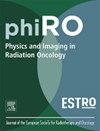基于人工智能的描绘工具在日常磁共振图像引导的适应性前列腺癌放疗中的可行性和时间增益。
IF 3.4
Q2 ONCOLOGY
引用次数: 0
摘要
背景与目的:日常磁共振图像(MRI)引导的放疗计划适应需要在在线工作流程中耗时的人工对目标和危险器官进行轮廓编辑。自动分割的最新进展有望在短时间内提供高质量的描述。然而,实际时间效益在临床设置是未知的。目前的研究调查了在1.5 T MRI-Linac上实现基于在线人工智能(AI)的描绘的可行性和时间增益。材料和方法:15例连续的前列腺癌患者,在1.5 T MRI-Linac下接受20组60 Gy的治疗。前5名患者(第一组)使用标准轮廓工作流程对所有部分进行治疗。最后10名患者(第2组)采用分数1至3的标准工作流程(第2组-标准)和基于人工智能的工作流程(第2组-人工智能)进行治疗。人工智能描述使用内部开发的人工智能推理服务和内部训练的nnU-Net提供。结果:基于人工智能的工作流程将描述时间从9.8分钟减少到5.3分钟。在治疗过程中,第1组的描述时间方差似乎有所增加,而基于人工智能的工作流程的描述时间不变(第2组-人工智能)。使用基于人工智能的工作流时,由于目标移动而导致的重新适应次数较少。结论:在1.5 T MRI-Linac上实施基于人工智能的工作流程是可行的,并且减少了描绘时间。较低的描述时间差异有助于更好地规划日常治疗计划并避免延误。本文章由计算机程序翻译,如有差异,请以英文原文为准。

Feasibility and time gain of implementing artificial intelligence-based delineation tools in daily magnetic resonance image-guided adaptive prostate cancer radiotherapy
Background and Purpose
Daily magnetic resonance image (MRI)-guided radiotherapy plan adaptation requires time-consuming manual contour edits of targets and organs at risk in the online workflow. Recent advances in auto-segmentation promise to deliver high-quality delineations within a short time frame. However, the actual time benefit in a clinical setting is unknown. The current study investigated the feasibility and time gain of implementing online artificial intelligence (AI)-based delineations at a 1.5 T MRI-Linac.
Materials and methods
Fifteen consecutive prostate cancer patients, treated to 60 Gy in 20 fractions at a 1.5 T MRI-Linac, were included in the study. The first 5 patients (Group 1) were treated using the standard contouring workflow for all fractions. The last 10 patients (Group 2) were treated with the standard workflow for fractions 1 up to 3 (Group 2 – Standard) and an AI-based workflow for the remaining fractions (Group 2 – AI). AI delineations were delivered using an in-house developed AI inference service and an in-house trained nnU-Net.
Results
The AI-based workflow reduced delineation time from 9.8 to 5.3 min. The variance in delineation time seemed to increase during the treatment course for Group 1, while the delineation time for the AI-based workflow was constant (Group 2 – AI). Fewer occurrences of readaptation due to target movement occurred with the AI-based workflow.
Conclusion
Implementing an AI-based workflow at the 1.5 T MRI-Linac is feasible and reduces the delineation time. Lower variance in delineation duration supports a better ability to plan daily treatment schedules and avoids delays.
求助全文
通过发布文献求助,成功后即可免费获取论文全文。
去求助
来源期刊

Physics and Imaging in Radiation Oncology
Physics and Astronomy-Radiation
CiteScore
5.30
自引率
18.90%
发文量
93
审稿时长
6 weeks
 求助内容:
求助内容: 应助结果提醒方式:
应助结果提醒方式:


